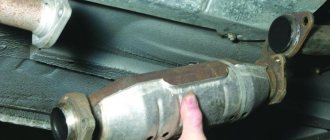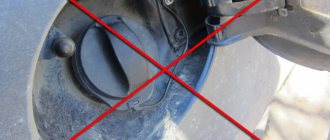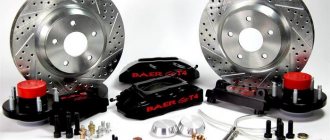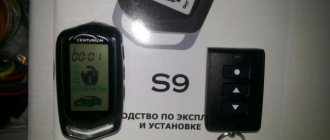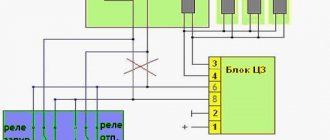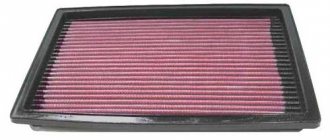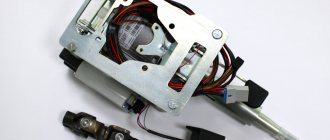Good day to all! If you are here, then you are definitely interested in a surround view system for a car.
It is a mistake to think that now you can only buy a car with factory equipment that includes such equipment. In fact, it is also possible to independently install a system capable of displaying what is happening around the vehicle at 360 degrees.
For the first time, such a development was proposed by Nissan engineers. The Japanese, as an option, equipped their cars with cameras that provided the same all-round visibility. Due to this, the parking system received a new round of development.
Purpose and functions of the all-round view
The all-round visibility system is part of the car's active safety. Its main task is to collect visual information around the car and then display it in the form of a circular panorama on the multimedia screen. This allows the driver to better navigate and fully control the situation around the car in difficult driving conditions or when parking. Thanks to this, the risk of emergency situations is significantly reduced.
If the automatic transmission selector is switched to reverse mode (R), the all-round visibility function is activated automatically. It can also be turned on forcibly using a button.
A similar system was first installed in 2007 on Nissan cars, called AVM, which stands for Around View Monitor . As a rule, the all-round viewing function is present in premium cars. However, now it can be installed in any car by first purchasing a ready-made kit with all sensors and a control unit.
Surround View System
Among the main functions are the following:
- the ability to accurately maneuver in confined spaces or off-road. The driver is shown a picture around the car in great detail, including the most “not visible” sections of the road;
- possibility of motion recording (optional).
In what situations is such equipment useful?
One gets the impression that such equipment can only be used for parking. However, it is not. The range of applications of such devices is much wider and is not limited to parking alone. So, cameras will also help in the following situations:
- When driving through blind intersections. Often, a camera mounted at the level of a car's radiator grill will be able to see much more than the driver. It is capable of ensuring safe passage through intersections with blind spots.
- When driving on narrow streets. Often the driver has to stretch out to his full height and look to see if his car is hitting obstacles in the form of cinder blocks, curbs, parking posts or other cars. This system makes driving in narrow areas easier.
- Orientation on the road. Some novice drivers are so superficially familiar with the dimensions of their car that they do not know how to pass a hole or other obstacle between the wheels. Often they don't even realize how far they are from other cars or medians. The all-round visibility system will make life much easier for amateur drivers.
Elements and principle of operation of the system
The all-round viewing system includes:
- 4-5 cameras with wide-angle views located on the sides, rear and front of the car;
- sensors that receive signals about obstacles around the car;
- multimedia screen (standard system or installed separately);
- Control block.
Modern all-round viewing systems, purchased separately, can be equipped with a video recorder. The installation of this element can be hidden or standard, which will provide additional protection for the vehicle when parked in unguarded areas.
Location of system components
The work is based on the collection of visual information by sensors (cameras) installed:
- in the rear-view mirrors (right and left, respectively);
- in the radiator grille;
- on the trunk lid or rear door.
Depending on the model and manufacturer of the system, there may be either 4 cameras or 5 video recording devices.
Due to the fact that the cameras provide panoramic shooting, the viewing angle is a full 360°. The viewing modes that are displayed on the multimedia screen are selected by the driver and can be as follows:
- parking – turns on automatically when the gearbox selector is moved to the “R” position (the speed should be no more than 10-20 km/h);
- panoramic – images from all installed video cameras are displayed on the screen simultaneously (top view);
- manual – selected independently by the driver and depends on the desired viewing position in a particular situation.
Installation Features
Objectively, a rear view camera is inferior in functionality and safety to a full-fledged and complete car vision system. Therefore, more and more car owners are thinking about upgrading their car and switching to a more advanced control scheme.
Now it’s not a problem to buy a complete set of full visibility on Aliexpress or other stores. And the price is quite reasonable. The main thing is that the components are of good quality and the connection is made correctly.
To connect a surround view, you need to purchase 3 components:
- smart screen, that is, a screen with a brain;
- at least 4 cameras;
- electrical installation equipment
In addition, you will need a standard set of tools, glue, cutting tools, etc.
As for screens, there are several options:
- Selecting a camera. Alternately displays images from different cameras. The driver can choose which camera to activate. But there is no need to talk about a full-fledged circular audit here;
- Screen with the function of simultaneous processing of data from 4 cameras. In this case, video from all cameras is displayed on the screen at once;
- A screen that shows 4 cameras composing and displaying the car in the form of a 3D panorama. It is these screens that are considered complete and complete display systems.
If we talk about cameras, then we need regular devices for parking in front and behind. They're pretty cheap. It’s better to take simple options without unnecessary features and boasting. Panoramic cameras with a wide viewing angle are needed on both the left and right sides.
Advantages and disadvantages
Vehicles equipped with an all-round visibility system have a number of advantages:
- the ability to constantly monitor the situation around the car both while driving on the road and while parking;
- all-round visibility and absence of blind spots, thanks to the panoramic image transmitted by the corresponding cameras;
- the ability to record the resulting video, use the system as a DVR.
Modern cars have received a lot of various auxiliary systems that significantly increase comfort and safety. Additional all-round viewing capabilities of the car allow the driver to easily obtain various information about what is happening around him on the road or while parking, as well as record the resulting image. If previously such systems were only available in expensive cars, today anyone can install them.
How it works
When the system is activated, the screen is usually divided into 2 parts. One of them shows a panoramic image, and the second shows an image from one of the cameras. Especially from the back.
The factory all-round visibility system is integrated into the parking sensors, with which the interaction takes place. This allows you to display a graph of the direction of travel on the screen, dividing zones into red and green, thus marking the distance to obstacles. In addition, the driver is notified by sound signals.
It is important to understand that 360-degree visibility usually works when driving at relatively low speeds. The system is activated automatically when reversing or manually using switches in the cabin.
Do-it-yourself car surround vision system
How to implement a car's all-round visibility system with your own hands?
I would like to immediately warn you that the process of installing such equipment requires you to have a fairly high level of technical training and, of course, hands growing from the right place.
If you bought a system kit for all-round viewing, but are not sure that you can handle it, it is better to contact specialists at the service center. Well, we’ll still briefly describe what you need to do to equip your car with all-round visibility:
- inspect the purchased kit, it usually contains four cameras, a display, a set of wires, connectors and other components;
- prepare tools for installation;
- Let's start installing the cameras - the rear one is usually located in the license plate frame or a little higher, a place is found for the front one in the radiator grille, and the two side ones are built into the rear-view mirrors;
- drawing signal wires, which should eventually converge at the place where the display will be installed;
- mounting the display on the dashboard or in the center console area.
All this work requires partial disassembly of the car's upholstery and panels in the interior, and integration into the electrical circuit of the car.
In a word, we cannot promise you a simple and easy pastime - you will have to tinker. But the result justifies all these actions and your expectations.
So friends, if you decide, go for it and enjoy the results of your work.
With that, thanks for your attention!
Don’t forget to subscribe to our blog, and if you like the site, tell your friends and acquaintances about it.
And its very name suggests that the system provides the driver with the opportunity to have information not only from side or rear cameras, but also from other cameras.
The system monitors blind spots. And it makes parking or getting around much easier when conditions are challenging. For example, if necessary, drive through some kind of intersection.
The purpose of the 360-degree view system is to assist the driver when maneuvering in tight spaces. We are talking about entering a “blind” intersection, perpendicular and parallel parking, and driving between lanes. In this case, the “multimedia” provides readings that are displayed on the head-mounted display.
Design of a car's all-round viewing system
All video cameras have high resolution. Thanks to this, it is possible to transmit an image that will have a high degree of detail.
The evolution of optical parking sensors has led to the appearance of all-round visibility. As a result, the rear camera makes parking easier.
For the first time, such an innovation was used on Nissan cars produced in Japan. Then it was picked up by other famous automakers on the planet. We are talking about BMW, Volkswagen, Mercedes, Toyota and others.
Installation recommendations
When everything necessary to install the all-round viewing system has been purchased and assembled, you can begin to work.
- At the first stage, you should determine all the places where the cameras will be located.
- It is recommended to install the rear camera first. You may need to cut a hole for it on the platform intended for fixing the license plate.
- After cutting, sand the area using sandpaper.
- The easiest way to fix the camera itself is with glue that is resistant to weathering and temperature changes.
- Then the front parking camera is mounted in the radiator grille area. For installation, the same principle applies as with the rear camera.
- Then comes the turn of the side cameras. They are mounted in mirrors, and this procedure causes much more difficulties. The mirrors themselves are first dismantled, a hole is made in the body for the camera and fixed in it.
- Using door connectors, the wiring is pulled into the interior. After this, the side mirrors return to their place.
- The wiring from the rear and front cameras also needs to be routed through the interior. Here you should act based on the design features of a particular car, existing technological holes, etc. You will probably have to remove the trunk trim. In the cabin, it is better to stretch along the floor than along the ceiling. It is important that during operation the driver or passenger does not touch the wires and cannot accidentally damage them.
- At the final stage, when the wires are connected to the monitor, the setup is performed. The setup procedure is carried out strictly according to the instructions from the display manufacturer.
Most ready-made kits for all-round viewing provide detailed instructions for connecting, installing and configuring the system.
